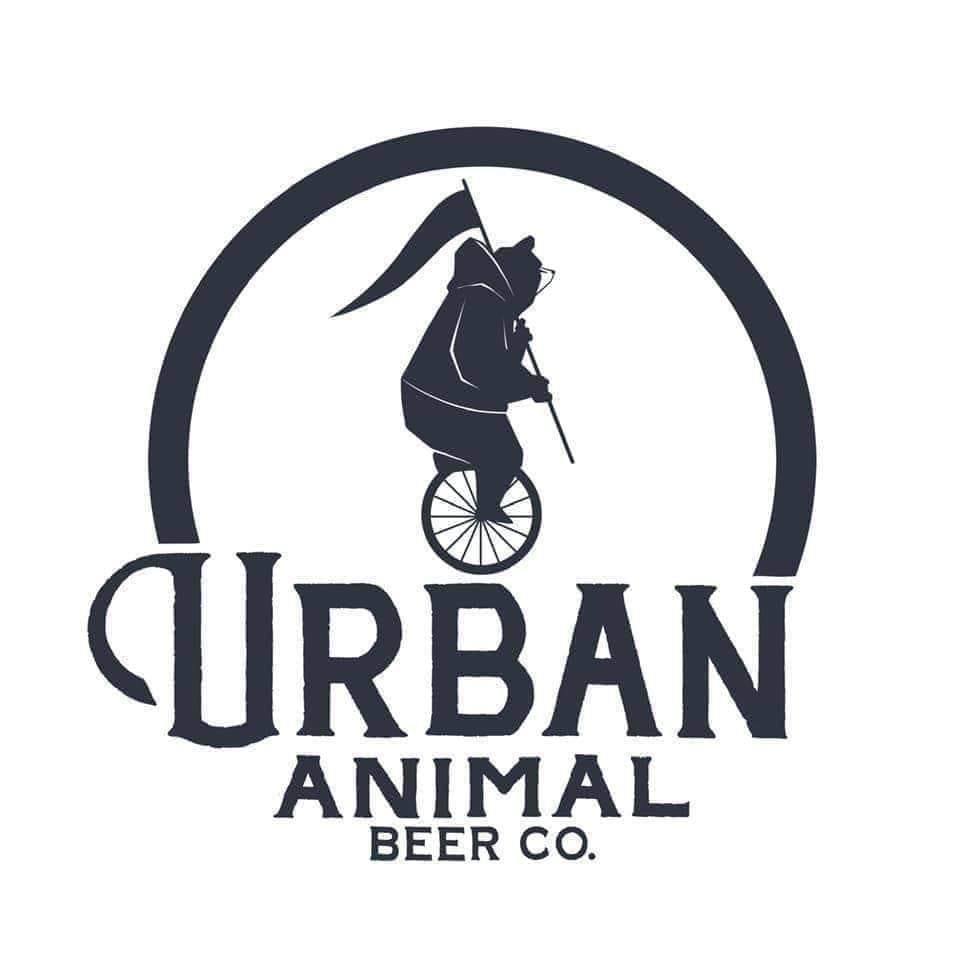It’s a treat to be invited into the personal home kitchen of a chef. RMFR was honored to do just that a few weeks ago by chef Mark Henry, known from his time with Brother Luck Street Eats and a winner of Food Network’s “Cooks vs. Cons,” among his many accolades. On a snowy night in late November we traveled to the Henry home in Fountain to learn how chef prepares a holiday ham.
Henry chose this festive dish because it’s not only user-friendly for all cooking levels, but offers a different take on your usual pie-spice-flavored meats.
“So whenever I do ham, I like to do Cuban ham, just because I feel like holiday hams and all those other flavors are too present already,” Henry says from his kitchen, where a pot roast is slowly finishing. His daughters do homework in the living room with his wife. “Like, there’s a lot of baking spices and nutmegs and all that shit are pretty prevalent, so I’m going to omit all of that.”
Over a few nips of Distillery 291’s Bad Guy Whiskey, as well as that pot roast paired with winter vegetables and mashed potatoes (yeah, we love our job), Henry swiftly prepared the shoulder and brine. All in all it took about an hour — the pork then resting in a salty bath for several days.
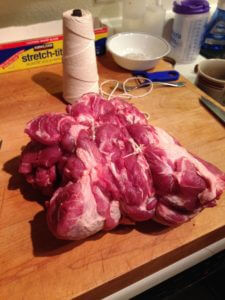
Naturally, Chef’s kitchen extends throughout much of the household. In the garage he showed us a whole, young pig he was keeping for later that week. We left with a frozen chicken from the family’s own flock, too. (Did we say we love our job?)
But back to the pork. Henry, as he is known, keeps the process streamlined and frill-free.
“[This is] going to enhance the flavor of the pork but not mask it,” Henry says. “You’re going to get some of the sugar from the orange, the brown sugar’s going to flavor it a little bit, but it’s not going to be super caramel-y. You get to taste the pork, which I think is important.”
Read on for the recipe, written for RMFR by the man himself, and happy holidays!
Mark Henry’s Holiday Ham Recipe
1 whole pork shoulder (Boston butt preferably, not picnic shoulder). This cut is optimal for this project as it will be as close to an 80/20 blend of protein/fat as you will get without having to add anything to it.
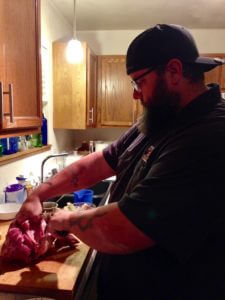
To de-bone:
Start with a sharp, thin bladed knife, such as a boning knife. Begin on the short end of the pork butt, where you can see the tip of the bone that has been cut using the bone saw. Begin to trace around the bone end, with the tip of your knife, following closely the edge of the bone, so as to not cut into the meat as much as possible. On the top side of the roast (the side with the fat cap) there will be a ridge in the center of the bone. Cut on either side of it progressively using more of the blade of the knife until all that remains attached on all sides of the bone is the ridge in the top center of the bone. To remove this bone completely, either slowly and carefully cut it out using the tip of your knife, or alternatively grip the bone with a dry kitchen towel, and pull in a jerking motion outwards away from the meat to separate the ridge from the meat.
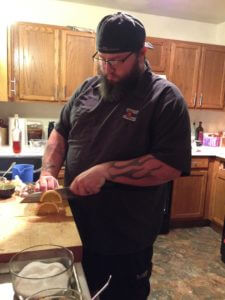
To prepare the brine:
1 tsp vegetable oil
1 onion (julienned or thinly sliced)
10 cloves of fresh garlic, macerated (scraped into a pulp using the side of your knife, and an aggregate such as Kosher salt)
1 C Kosher salt
3/4 C brown sugar
1 tsp crushed red pepper flakes
1 orange, thinly sliced
2 Qts water
3 Qts ice
Method:
Once you have boned the pork shoulder, truss it using butcher’s twine to create an evenly thick mass of protein, to ensure proper brine distribution, as well as even cooking of the ham.
Meanwhile, in a large, heavy bottomed pot, heat the oil, and sweat the onion and garlic, until just starting to turn translucent, and it becomes very aromatic.
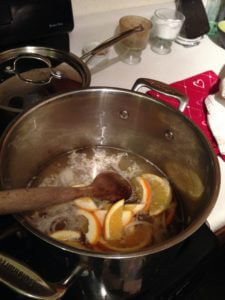
Then add the salt, brown sugar, crushed red pepper, orange slices, and 2 quarts of water. Bring to a boil over high heat, once a rolling boil has been achieved, reduce the heat to a simmer, and simmer just long enough to dissolve the salt and sugar.
Once the solids have been dissolved, remove immediately from the heat, and add the ice. Once the brine has cooled to room temperature or lower, add the pork shoulder, and let brine for 60-72 hours.
After the allotted brining time has elapsed, remove from brine and place on a sheet pan, in the refrigerator overnight, uncovered to allow the brine to evenly distribute throughout the ham.
To finish, either roast the ham in the oven at a setting of 350 degrees until an internal temperature of 153 has been achieved, or smoke using your favorite wood chips until the same internal temperature has been achieved.

[Images: Edie Crawford and Mark Henry]



